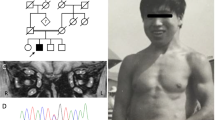Abstract
Two young boys were referred for evaluation of metabolic myopathy because of elevated serum levels of creatine kinase, cramps and pigmenturia. Immunohistochemical studies of dystrophin in muscle biopsies showed reduced intensity of the stain with a patchy and discontinous pattern in most fibers. In both patients dystrophin was undetectable by immunoblotting. DNA analysis of the dystrophin gene was not informative in one patient; in the other it revealed an in-frame deletion comprising exons 3–6. These observations suggest that the two patients are affected with an unusual phenotype of Becker muscular dystrophy. Dystrophin analysis should be included in the evaluation of patients with childhood-onset of recurrent myoglobinuria.
Similar content being viewed by others
Abbreviations
- BMD:
-
Becker muscular dystrophy
- CK:
-
creatine kinase
- CPT:
-
carnitine palmitoyl transferase
- DMD:
-
Duchenne muscular dystrophy
- PCR:
-
polymeras chain reaction
- PFK:
-
phosphofructokinase
References
Beggs AH, Koenig M, Boyce FM, Kunkel LM (1990) Detection of 98% of DMD/BMD gene deletions by polymerase chain reaction. Hum Genet 86:45–48
Beggs AH, Hoffman EP, Snyder JR, et al (1991) Exploring the molecular basis for variability among patients with Becker muscular dystrophy: dystrophin gene and protein studies. Am J Hum Genet 99:54–67
Bradley WG, Jones MZ, Mussini JM, Fawcett PRW (1978) Becker-type muscular dystrophy. Muscle Nerve 1:111–132
Chamberlain JS, Gibbs RA, Ranier JE, Caskey CT (1989) Multiplex PCR for the diagnosis of Duchenne muscular dystrophy. In. Innis M, Getland D, Sninsky J, White T (eds) PCR protocols: a guide to methods and applications. Academic Press, Orlando, pp 272–281
Chang HW, Bock E, Bonilla E (1989) Dystrophin in electric organ of Torpedo californica homologous to that in human muscle. J Biol Chem 264:20831–20834
Gold R, Kress W, Meurers B, Meng G, Reichman H, Muller CR (1992) Becker muscular dystrophy: detection of unusual disease courses b combined approach to dystrophin analysis. Muscle Nerve 15:214–218
Gospe SM, Lazaro RP, Lava NS, et al (1989) Familial X-linked myalgia and cramps: a non-progressive myopathy associated with a deletion in the dystrophin gene. Neurology 39:1277–1280
Heiman-Patterson TD, Natter HM, Rosenberg H, Fletcher JE, Tahmoush AJ (1986) Malignant hyperthermia susceptibility in X-linked muscle dystrophies. Pediatr Neurol 2:356–358
Hoffman EP, Brown RH, Kunkel LM (1987) Dystrophin: the protein product of the Duchenne muscular dystrophy locus. Cell 51:919–992
Hoffman EP, Fischbeck KH, Brown RH, et al (1988) Dystrophin characterization in muscle biopsies from Duchenne and Becker muscular dystrophy patients. N Engl J Med 318:1363–1368
Hoffman EP, Kunkel LM, Angelini C, Clarke A, Johnson M, Harris JB (1989) Improved diagnosis of Becker muscular dystrophy by dystrophin testing. Neurology 39:1011–1017
Hu X, Ray PN, Murphy EG, Thompson MW, Worton RG (1990) Duplication mutation at the Duchenne muscular dystrophy locus: its frequency, distribution, origin and phenotype/genotype correlation. Am J Hum Genet 46:682–695
Koenig M, Monaco AP, Kunkel LM (1988) The complete sequence of dystrophin predicts a rod-shaped cytoskeletal protein. Cell 53:219–228
Medori R, Brooke MH, Waterson RH (1989) Two dissimilar brothers with Becker muscular dystrophy have an identical genetic defect. Neurology 39:1493–1496
Minetti C, Chang HW, Medori R, et al (1991) Dystrophin deficiency in young girls with sporadic myopathy and normal karyotype. Neurology 41:1288–1292
Monaco AP, Bertelson CJ, Liechti-Gallati S, Moser H, Kunkel LM (1988) An explanation for the phenotypic differences between patients bearing partial deletions of the DMD locus. Genomics 2:90–95
Nicholson LVB, Johnson MA, Gardner-Medwin D, Bhattacharya S, Harris JB (1990) Heterogeneity of dystrophin expression in patients with Duchenne and Becker muscular dystrophy. Acta Neuropathol 80:239–250
Sunohara N, Arahata K, Hoffman EP, et al (1990) Quadriceps myopathy: a forme fruste of Becker muscular dystrophy. Ann Neurol 27:181–185
Tein I, DiMauro S, DeVivo DC (1990) Recurrent childhood myoglobinura. Adv Pediatr 37:77–117
Tonin P, Lewis P, Servidei S, DiMauro S (1990) Metabolic causes of myoglobinuria. Ann Neurol 27:181–185
Author information
Authors and Affiliations
Rights and permissions
About this article
Cite this article
Minetti, C., Tanji, K., Chang, H.W. et al. Dystrophinopathy in two young boys with exercise-induced cramps and myoglobinuria. Eur J Pediatr 152, 848–851 (1993). https://doi.org/10.1007/BF02073385
Received:
Accepted:
Issue Date:
DOI: https://doi.org/10.1007/BF02073385




